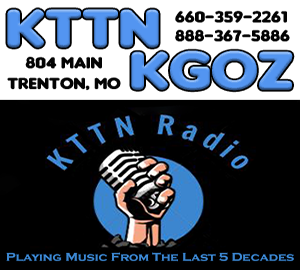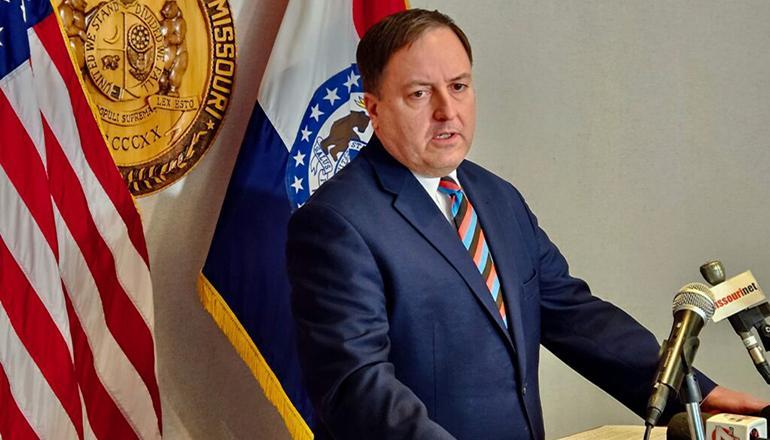(Missouri Independent) – Secretary of State Jay Ashcroft wants to eliminate Missouri’s income tax, which provides two out of every three dollars in the state’s general revenue fund, and says budget cuts can pay for it.
To help craft the plan, Ashcroft has enlisted some of the well-known conservative economists and low-tax advocates that advised then-Kansas Gov. Sam Brownback on a massive tax cut enacted in that state in 2012. The resulting plunge in revenues led to the repeal of the cuts in 2017 and contributed to Republicans losing the Kansas governorship in the 2018 election.
Ashcroft, one of the leading candidates for the Republican nomination for governor, said he will not repeat the Kansas debacle.
“I can’t tell you we’re going to repeal the income tax all in one day,” Ashcroft said in an interview with The Independent. “It’s not going to work out that way. But we’re going to put the state on the glide path to do that.”
Ashcroft also wants to repeal the 12.5-cent per gallon fuel tax increase enacted in 2021. That increase is being phased in at 2.5 cents per year. So far, 7.5 cents has taken effect, with another 2.5 cents per gallon to be added on July 1 and again on July 1, 2025.
A lawsuit that found the Highways and Transportation Commission had the authority to use money in the state Road Fund to finance a program to raise salaries shows the new tax wasn’t really needed, Ashcroft said. The October ruling is being appealed and no raises beyond the general state pay plan have been awarded.
“When that gas tax got passed, the immediate thing that transportation did was they started giving out salary increases to people,” Ashcroft said. “It wasn’t about new roads. It wasn’t about repairing roads. First and foremost. It was about new salaries.”
The $50 million salary plan was the Missouri Highways and Transportation Commission’s reaction to rapid turnover in the department. The tax increase, when fully implemented, was expected to add $337.5 million annually to the state road fund and provide $125 million for city and county governments to spend on local roads when it was passed in 2021.
The department said at the time that the extra money was essential to matching available federal highway funds.
Ashcroft unveiled his tax proposal last week and it immediately drew sarcastic criticism from one of his rivals for the nomination, state Sen. Bill Eigel of Weldon Spring.
“Nice to have you endorsing my plans…,” Eigel wrote on social media. “Where have you been the last 8 years? If only you were a real conservative in office, not just during the campaign…”
On his campaign website, Eigel states he wants to eliminate both the personal and corporate income taxes and the personal property tax that almost entirely funds local government operations.
Lt. Gov. Mike Kehoe, the other Republican running a full-scale campaign for the nomination, has not posted any stands on tax policy on his campaign website or reacted to Ashcroft’s proposal on social media.
In a statement issued by campaign spokesman Mike Hafner, the Kehoe campaign takes partial credit for the tax cuts enacted while he was in the Senate, saying he voted for tax cuts totaling $2.5 billion.
Kehoe, like Ashcroft and Eigel, wants to repeal the income tax, the statement read.
“As governor, Mike will continue this progress by working to eliminate the income tax altogether and control state spending,” the statement read.
Democratic candidates for governor asked for reactions to Ashcroft’s proposal and noted the overlapping of low-tax advocates of the group that advised Brownback in Kansas and the “task force of experts” Ashcroft says he enlisted to help him.
At least three – Arthur Laffer, creator of the Laffer Curve purporting to show the relationship between tax rates and total revenue; Stephen Moore of the Heritage Foundation; and Jonathan Williams of the American Legislative Exchange Council – were on Brownback’s advisory panel.
Other prominent names are Grover Norquist, who founded Americans for Tax Reform, and Aaron Hedlund, a former University of Missouri economist who now works at Purdue University, who was chief economist for the White House Council of Economic Advisers during President Donald Trump’s final year in office.
Norquist, in 2015, two years after Brownback’s cuts and at a time when revenues were far short of projections, said other states should emulate its moves.
“Kansas is the future,” he said in an interview. “Kansas is the model.”
House Minority Leader Crystal Quade of Springfield, a Democrat running for governor, said Missouri’s current tax system needs reform, but “trusting the same people who thought up the failed Brownback debacle in Kansas would be laughable if the stakes for hardworking Missouri families weren’t so dire.”
Quade’s chief opponent in the Democratic primary, businessman Mike Hamra of Springfield, also noted the links to the Kansas cuts.
“This is a strategy for earning Grover Norquist’s support and funding in the primary, not a realistic plan for moving Missouri forward,” Hamra said. “Kansas tried this experiment a decade ago with disastrous results – a budget crisis, schools closing weeks early, multiple credit downgrades, and slowed economic growth.”
Budget cuts
Ashcroft, in the interview, did not name any new source of revenue he would propose to replace the almost $10 billion generated by the income tax.
Instead, he said, every dollar spent by the state should be examined and if it does not pay for education, public safety or “roads, bridges and waterways,” it should be reduced or eliminated.
“It’s gonna have to be kind of a starting from the beginning, what are the core responsibilities of the government, and then how do we pay for those core responsibilities?” Ashcroft said.
There are numerous earmarked funds in state government, ranging from fees paid to licensing boards and appropriated for regulatory operations to taxes that pay for conservation and state parks.
Missourians should be asked if they want to retain those earmarked accounts or put all the money into the general revenue fund for appropriation as determined by lawmakers, Ashcroft said.
“We need to not just figure out how to limp along for another five to 10 years, but how do we put our state on the path we want for the next 30 or 40?” Ashcroft said. “And it’s going to have to be looking at not just a general revenue, it’s going to be looking at some of those special funds and going back to people.”
In the webpage on his tax plan, Ashcroft cites states that have no income tax as having superior economies. Some of those states, like Tennessee and Texas, have high sales tax rates and others, like Alaska, have taxes on extraction of natural resources that provide the bulk of state revenues.
Missouri is already a high sales tax state, mainly because local option taxes, on average, almost double the 4.225% rate imposed for state purposes.
When pressed on where he would find the revenue to operate state programs without an income tax, Ashcroft again referred to the need to cut spending.
“You’ve got to cut and that’s the hardest thing for any elected official to do because they want to be able to hand out stuff,” Ashcroft said.
Income taxes
From 1972 to 2018, the top income tax rate in Missouri was 6% of taxable income above $9,000.
The last time the tax code was changed so the income tax would produce more revenue was in 1993 when lawmakers capped the deduction for federal income taxes so wealthy Missourians would pay more in state taxes.
The corporate income tax rate was also increased in 1993 and was set at 6.25%.
Soon after Kansas enacted its tax cuts in 2012, the Republican supermajorities in the Missouri legislature tried to follow suit. With the dire results of immediate sharp cuts apparent by 2014, a bill passed over the veto of Gov. Jay Nixon made small cuts of 0.1 percentage point in the top rate contingent on an annual revenue growth target of $150 million.
The growth trigger wasn’t achieved until fiscal 2017 and the first cut took effect on Jan. 1, 2018.
Since Republicans took control of the executive branch with the election of Eric Greitens in 2016, the cuts have accelerated.
This year, the top tax rate is 4.8% for taxable incomes greater than $8,911. There are three adjustments of 0.1 percentage point to come that will be triggered by revenue growth of at least $200 million.
In the period since the first income tax cuts took effect, income tax receipts have increased from $7.2 billion in fiscal 2018 to just under $10 billion in the year that ended June 30.
When the next cut will occur is uncertain. Revenue is expected to fall 0.7% in the current year and actual receipts through Friday show a decline slightly larger than that amount. And revenue is not expected to grow substantially in the coming fiscal year.
That means the next reduction in the top income tax rate would not occur until at least Jan. 1, 2027.
Republicans have also been busy exempting income from taxation and cutting the corporate tax.
The 2014 tax law also cut the percentage of income from businesses that is reported on personal tax returns, taxing only 75% of the total.
Quade, in a statement, argued those tax cuts overwhelmingly benefited higher-income Missourians.
“The last few income tax cuts passed by Republicans have overwhelmingly given the rich tax breaks,” she said, “while working Missourians save pennies.”
Last year, lawmakers passed a bill making Social Security and retirement income off-limits for the state income tax.
The corporate tax rate was cut to 4% effective in 2020, and the Missouri House is poised to pass a bill this year completely eliminating the tax.
The general revenue fund took in $14.8 billion in the year that ended June 30, before paying out refunds. The personal income tax provided just over two-thirds of that amount, with another 20% from sales tax.
Corporate taxes made up 7.1% of the total or about half the amount that didn’t come from personal income or sales taxes. The rest comes from interest on daily balances, liquor and beer taxes and other small levies.
The Missouri Constitution requires “twenty-five percent of the state revenue, exclusive of interest and sinking fund, to be applied annually to the support of the free public schools.”
(Photo by Rudi Keller – Missouri Independent)


